This fermented honey garlic is the perfect thing to make to boost your immune system! Both honey and garlic have strong medicinal benefits, so you’ll want to have this delicious home remedy on hand for cold and flu season.
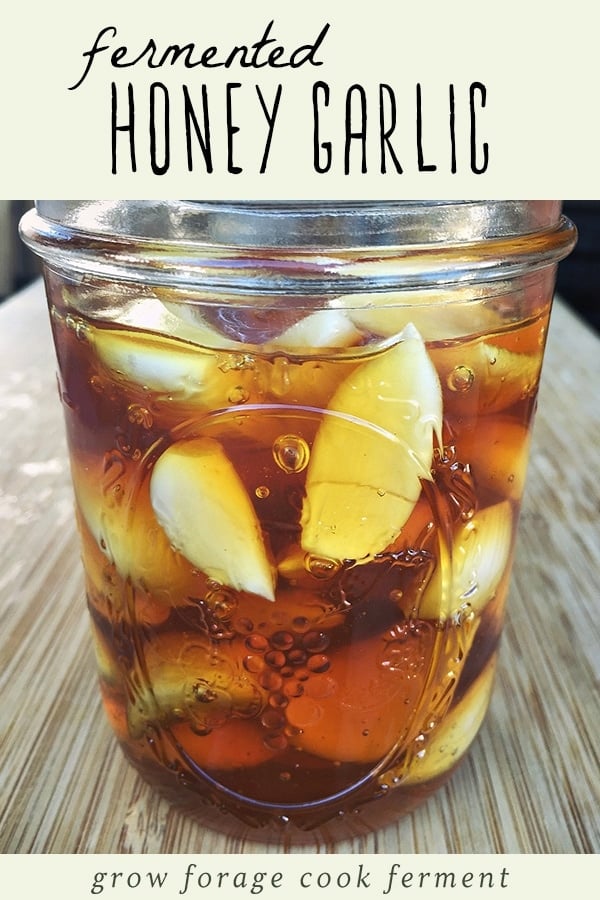
Want to save this post for later?
Fermenting Garlic in Honey
I’m really excited to share this post with you! Fermented honey garlic is something I’ve been wanting to try for a very long time.
I usually reserve my honey for mead making, but using it for other ferments intrigued me. Don’t ask me why I haven’t done it until now, because it’s the easiest thing in the world!
This tasty fermented garlic in honey can be used for many things, as good food and good medicine. Honestly though, I like to just eat it as is!
Fermented Honey Garlic Recipe
Making fermented honey garlic is so easy, it hardly needs a recipe!
Prepare the Garlic
The hardest and most time consuming part is prepping all of the garlic. Whatever size jar you use, you’ll want to fill it about 1/2-3/4 full of peeled garlic.
The quickest and easiest way to prep garlic is to place the side of a chef’s knife on top of a single clove and then give it a firm whack with the palm of your hand.
Don’t do it too hard, as you don’t want to crush the garlic, but just enough to lightly bruise the it. This will make it easy to peel, and will also release a bit of the garlic juice.
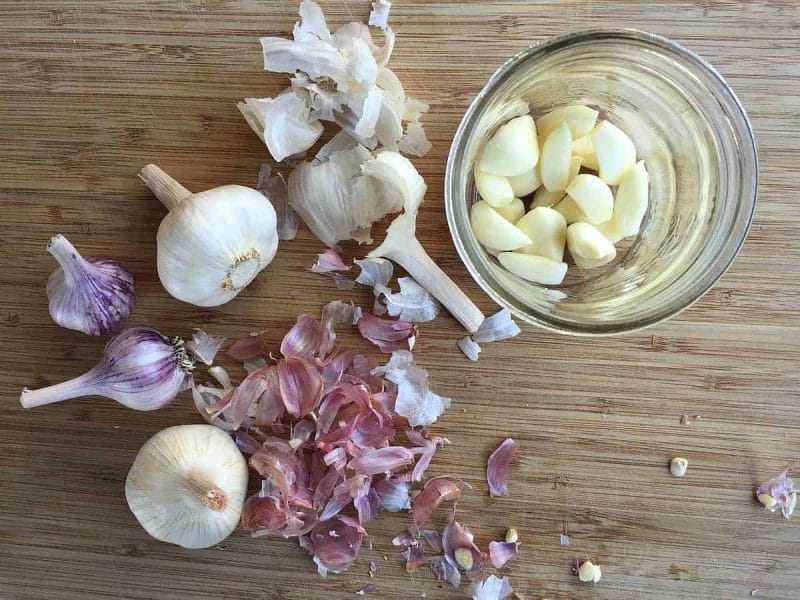
Add the Honey
Once you have enough garlic in your jar, pour in some raw honey to cover it. The garlic will probably float a bit and that’s ok.
It’s important to use raw honey to make fermented garlic in honey, as it will still have all the bacteria and wild yeast that is necessary for fermentation.
When liquid is added to honey, it jump starts the fermentation process. The small amount of juice from the garlic will create just enough liquid for fermentation to happen.
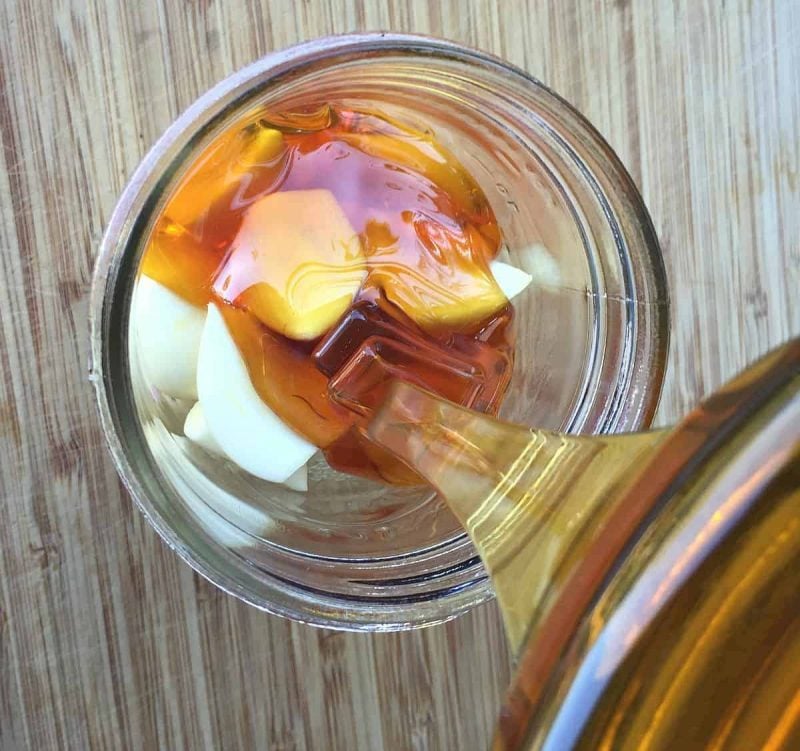
Cover and Flip
Cover the jar loosely with a lid to let the gasses escape, and put it in a dark place to ferment.
It’s a good idea to put a plate or something similar underneath the jar as it’s fermenting, as it will likely bubble up a bit and a little honey could possibly drip out.
It’s also important to gently turn the jar over every day or so, or whenever you think about it, to make sure that all of the garlic stay coated with honey.
Screw the lid on tightly before you do this! Then return it to it’s upright position and re-loosen the lid.
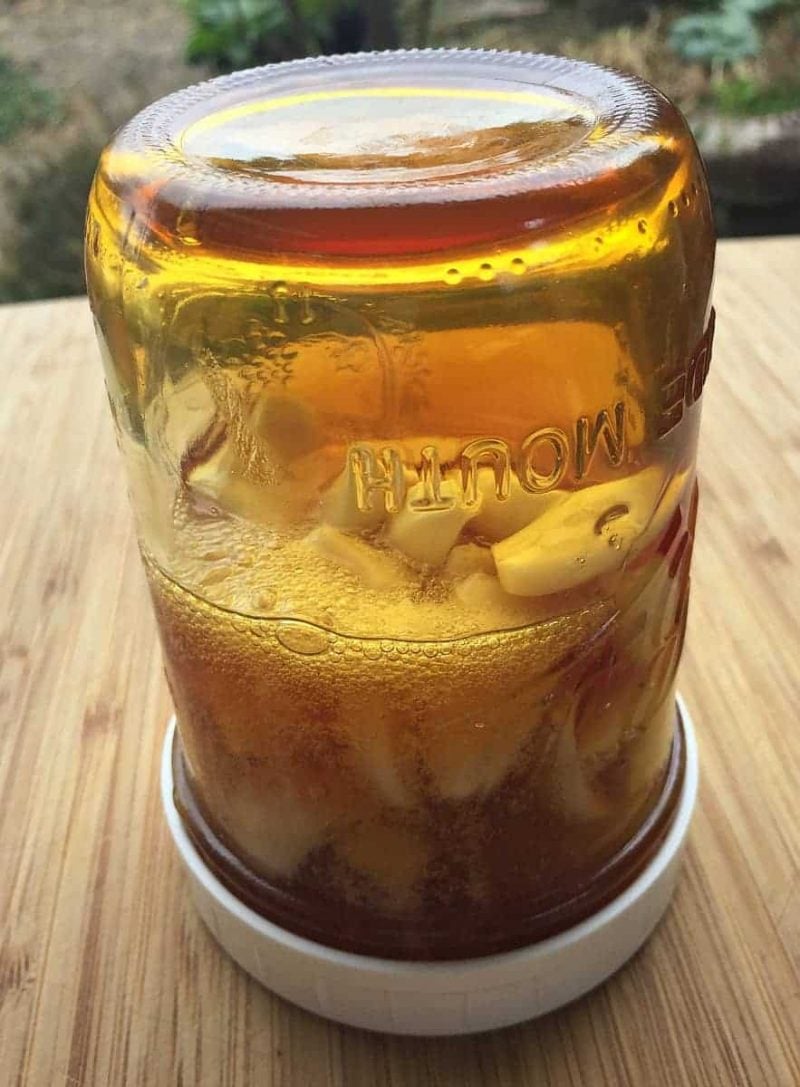
In a few days to a week you will notice some bubbles forming on the surface of the honey. Hooray!
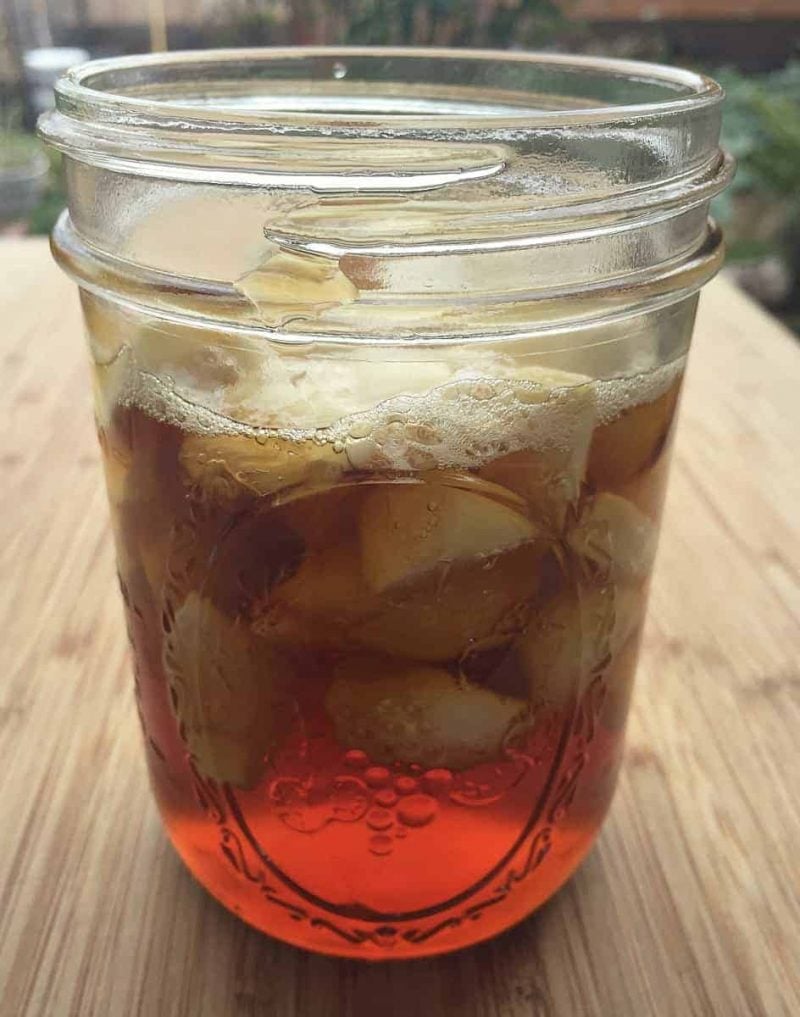
The honey garlic will ferment for about a month, but you can eat it at any time during the process.
The flavor will continue to develop over time, the garlic will mellow, and the honey will become much runnier.
Occasionally the garlic cloves turn a blue or green color due to a reaction during the fermentation process. While it may be a bit alarming, it is not harmful and the honey garlic can still be used.
Honey garlic will store well in a cool place for many months, or even a year or longer! I’ve kept some for over two years and it is still good.
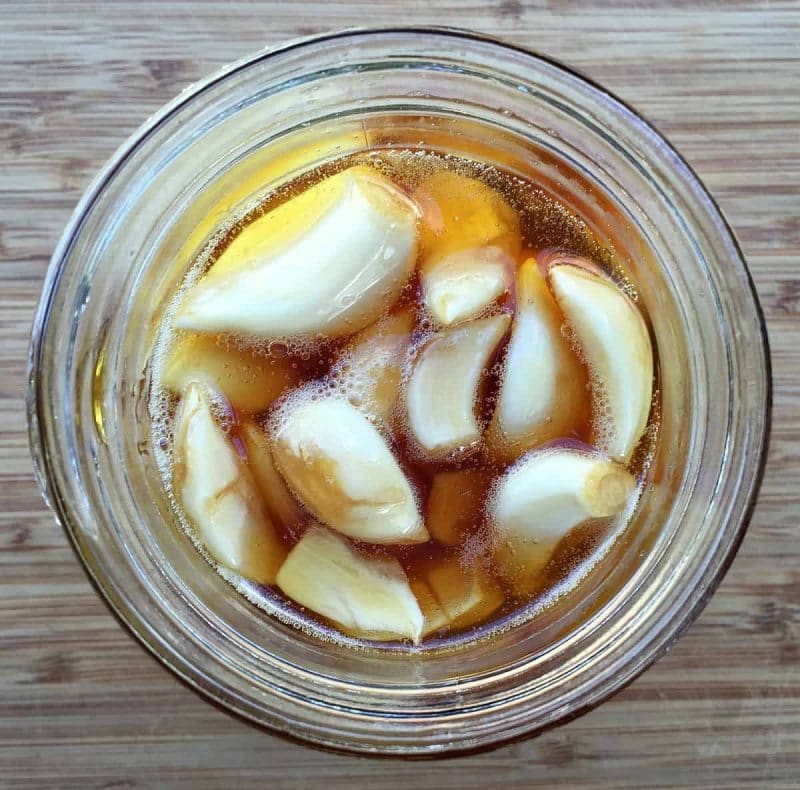
Using Fermented Honey Garlic
Now, how do you use this fermented honey garlic? That’s a good question, and it can be used in a variety of ways.
Both garlic and honey have strong medicinal properties, so it makes sense to use it as an immune booster or if you feel a cold or flu coming on.
Pop a whole garlic clove, or take a spoonful of honey (or both!).
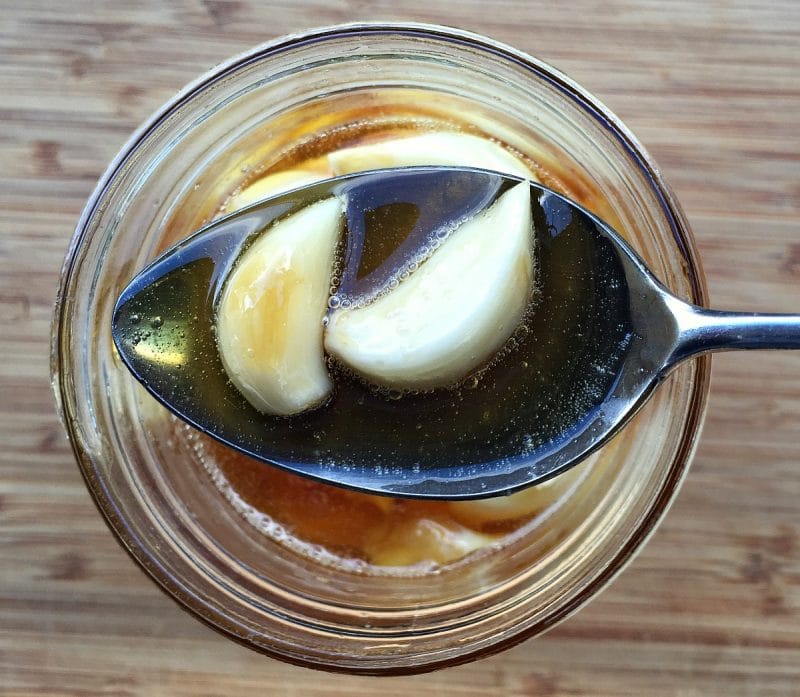
As you can probably imagine, honey garlic also makes a wonderful food!
It’s a natural in marinades and sauces, and would make a really tasty glaze for meats or veggies. Basically anything where you would normally use honey and garlic together!
Is Botulism a Concern in Honey Garlic?
I get this question a lot about fermented honey garlic! The short answer is no, botulism is really not a concern in this type of ferment.
While botulism can happen in garlic and oil preparations without added acidity, the fermentation process that happens here makes it very unlikely.
Raw honey is acidic, and while it can carry botulism spores (which is why it is not recommended for babies under 1 year), the level of acidity stops them from reproducing, which is what causes botulism.
If you are concerned about it, use a pH test strip. Botulism spores can’t reproduce with a pH of less than 4.6. Honey is usually around 3.9, but that can vary between brands.
If the pH is too high, add a splash of raw apple cider vinegar to add more acidity and retest. This is generally not needed, but I did want to mention it.
Honey garlic should not be given to babies under one year of age.
I really hope you make this yummy honeyed garlic! It’s super easy, and great to have on hand. I have a feeling it’s going to become a staple in our house!
Have you ever made fermented honey garlic? How do you use it?
More Fermented and Infused Honey Recipes
Enjoy these other recipes that showcase fermented and infused honey!
- Fermented Honey Cranberries
- Fermented Elderberry Honey
- Herbal Infused Honey
- Lilac Flower Infused Honey
Fermented Honey Garlic
Equipment
Ingredients
- 1 cup whole garlic cloves peeled and slightly crushed
- 1 cup raw honey or more, as needed to cover garlic
Instructions
- Place the peeled garlic cloves into a wide-mouth pint sized mason jar. Add enough honey to completely cover the garlic cloves. Make sure they are coated with honey.
- Place the lid on the jar loosely, then tuck into a dark place.
- Every day or so, tighten the lid on the jar and flip it upside down to coat the garlic cloves with honey. Loosen the lid again when you return it to the upright position.
- Within a few days to a week, you should see small bubbles start to form on the surface of the honey.
- The honey garlic will ferment for about a month, but you can eat it at any time. The flavor will continue to develop over time, the garlic will mellow, and the honey will become much runnier.
- Store in a cool place for many months or even a year, if not longer.
Notes
- It’s important to use raw honey for this recipe, as it has all of the bacteria and wild yeast that is necessary for fermentation.
- The small amount of juice from the garlic will create just enough liquid for fermentation to happen.
- It’s a good idea to put a plate underneath the jar during fermentation, as it will likely bubble up and a little bit of honey could possibly drip out.
- Occasionally the garlic cloves turn a bluish or greenish color during the fermentation process. While it may be a bit alarming, it is not harmful and the honey garlic can still be used.
- If you are concerned about botulism, use a pH test strip. Botulism spores can't reproduce with a pH of less than 4.6. Honey is usually around 3.9, but that can vary between brands.
- If the pH is too high, add a splash of raw apple cider vinegar to add more acidity and retest. This is generally not needed, but I do want to mention it.
- Honey garlic should not be given to babies under one year of age.

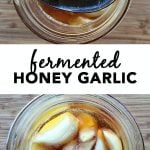
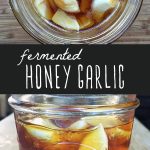
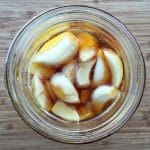

Hello, I was wondering how thin the honey is supposed to get. I put it in on a Saturday afternoon and by Thursday it’s very thin. I covered the garlic, added a bit of act, and burp and flip everyday. First time doing anything like this, not sure what to expect.
It can get pretty thin. It’s hard for me to say exactly how thin. I think it depends on the honey you used.
Thanks for the reply. It looks ok, and smells good I used a bit more honey not much. Maybe crushed some of the garlic too much. Oh well first try. :)
When I made the honey and garlic I left my jar on the counter for about 5-7 days and didn’t place it in a dark cabinet. Do you think it is still safe to use?
It should be, but you could add a splash or two of ACV if you’re worried about the pH.
Good morning, so I have been making this for several years, and just recently found a hidden jar from march of 22, would it still be good? The garlic is discolored, and I read that it is a chemical process. What would you suggest? Thanks ever so much!
Kandy
As long as it still smells good and is free from mold, it should be fine. If you’re worried, you could always add a splash of ACV to regulate the pH.
Can I take it everyday?
For sure!
Do NOT use a metal spoon with honey. It ruins the enzymes that are beneficial.
Once fermentation is done, is it okay if the garlic is not fully submerged? Or will it sink?
It doesn’t need to be submerged, but I occasionally will give it a shake (with the lid screwed down) to make sure there’s still a layer of honey coating the garlic.
I froze our homegrown garlic, do you think I could use it to make the fermented honey garlic?
Hi Cathy. I think it’ll still work.
Hello, I’ve been looking around other websites for insight if this is a safe natural remedy while pregnant. I live in the northeast and am no doubt going to have a head cold this winter. Do you have any information on that?
Hi Sarah. I don’t, but I personally wouldn’t risk it.
Hi there!
Great recipe, exactly what I was looking for, so thank you very much.
Do you have some tips for the use of the garlic after fermenting? Can I chop it up for a dressing or marinade? Or uwe it in a warmed-up broth?
Have to get some organic garlic tomorrow to get my Honey started : )
You can use it however you like! Dressing, marinade, drizzled over veggies or crusty bread, the possibilities are endless. When I feel cold coming on, I take a spoonful of the honey straight from the jar.
Can I blend this in a blender, it’s about a month old, no way my kids will eat a clove (12,13 Ava 14 years old)
You can do whatever you want with it!
Hi….I just have a question. I have bees/honey…and a ton of garlic I grow. So….bulbs are enormous, only 4 cloves per bulb. Will cutting them ( a clove) into 4 make too much liquid? And if thats OK….do I still need to slightly crush each piece? Thanks….
Hi Shirley. That should be fine! You can crush them slightly if you want, but it’s not totally necessary.
I just tried mine today for the first time. It turned out great! I only made one this time because I didn’t know what it would taste like, you will be happy to hear that the wife and I both love it! I’ll be making more tomorrow. Thank You, Lou Reihms
I’m so glad, Louis. Enjoy!
With this fermented honey garlic recipe, does the garlic ooze through your pores and you smell like garlic…Like when you eat raw garlic?
Not that I’m aware of.
Mine sat for just about a month but never really got bubbly, it is thinner now can I eat it even if it didn’t really ferment?
Yup!
My wife and I have been attempting to do a honey garlic fermentation and a running into some small problems. A lot of the honey is floating to the top and we can’t keep it submerged beneath the honey. We bought some fermentation weights but they’re not helping the situation. I have also tried to remove one of the weights with a spoon out of the drawer and now worried that because it wasn’t sanitized I have ruined the batch. Would love to have your thoughts. Thank you so much for your post and all that you do.
The garlic only needs to be covered in a thin layer of honey, it doesn’t have to be completely submerged at all times. Flipping the jar daily recoats the honey.
Hi I was wondering, I recently just made two jars, I followed recipe to a T. The only thing I didn’t do was slightly crush the garlic will this effect the remedy ?
Thanks!
Yup, totally fine.
Hi can I add more honey to the jar as I use it ? That way I always will have some
Hi Karen. It’s best to finish the jar and start a new one to prevent cross contamination.
I started mine a few days ago. Will the garlic stay hard or will it get soft and absorb some of the honey in the process?
It’ll absorb the honey as it ferments.
Hi! My garlic cloves keep floating to the top so that they are no longer covered by the honey. Is there anything I should be doing to try and keep them under the honey? Concerned about mold/contamination if I can’t keep the cloves submerged.
Are you flipping the jar every day? As long as the garlic has a thin coat of honey on them, they should be fine.
Hi! So I wish I would have seen your recipe before! I heard about this a few months ago, mines been in the cabinet for awhile but my honey didn’t say it was raw… is mine safe to eat?
It is really hard for me to say. If you didn’t use raw honey, it didn’t ferment. You can take a pH test to see if it’s in a safe range to consume.
I noticed that when you have the jar upside down there is a white plastic lid. Is this one of the normal plastic lids for mason jars? A friend gets hers at Walmart, a generic brand. So no need for a metal lid and ring? Love the recipe!
Hi Barb! Yes, mine is the same generic one. It’s best not to use a metal ring, as sometimes they can rust during the fermentation process.
Hi, do I need to sterilize the jar first?
I just wash it with hot soap water.
What’s the “dose” per day? Does it change for kids?
I eat it a tablespoon or so. There’s no real limit to how much you can eat. It’s food. Only babies under 1 year shouldn’t have raw honey.
Do I need to loosen and tighten the lid after a month? Or just leave it loose in a dark area? Thanks!
As long as there are no more bubbles coming to the surface, you can tighten the lid.
I didn’t really crush my garlic, I just shook it in a container until it all peeled, however mine stopped bubbling and the honey consistency is thinner. Hopefully it should be ok? Or do I need to do it over and bruise the garlic?
The bruising is unnecessary for fermentation. You’re all good!
Hi there! I made this about a month ago and it’s going great! As far as using it, can I cook with the garlic like I normally would? Or does that ruin the healing properties?
Cooking with it destroys the good bacteria that you cultivated during fermentation, so I would use it drizzled over veggies, meat, grains, etc.
Is there any need to burp the jar during the bubbling process or will simply loosening the lid after turning it back over be just as effective at letting the gasses escape?
The jar lid should be loose the entire time (except when flipping it), eliminating the need to burp at all.
Hey! I made it about a month ago and it’s going great. The consistency is thin and the bubbles have stopped. When storing in a dark dry place should I strain out the garlic and leave it in? Will tightening the lid for storage make it explode lol? Thank you!!
I leave the garlic in. As long as there are no more bubbles, it should be safe from exploding!
So I made this a month ago and I feel like it’s done. Do I need to put it in the fridge ever to stop fermentation?
No. It doesn’t need to be refrigerated. I keep it in a cool, dark cabinet.
Hi! I was wondering – once the bubbling stops… do you screw the lid all the way on then? And use the honey as needed, replacing the lid on tight?
I made a batch before finding your recipe and it must have got contaminated because the honey got thick and turned more white. I was just “burping” the jar daily. I tossed it.
Thanks!
Yes, that’s correct. When the bubbling stops, I close the lid completely and store in a cool, dark cabinet until I’m ready to use.
I am using elephant garlic with very large cloves. Is it okay to cut them into smaller pieces before I start the fermentation?
Thank you
Yup!
Hi I noticed you said not to add more honey if it spills. I end up doing that right in the beginning when after I first flipped it to flip it back. Should I redo it in case it was contaminated?
Hi Jay. It’s most likely fine as long as there’s no mold.